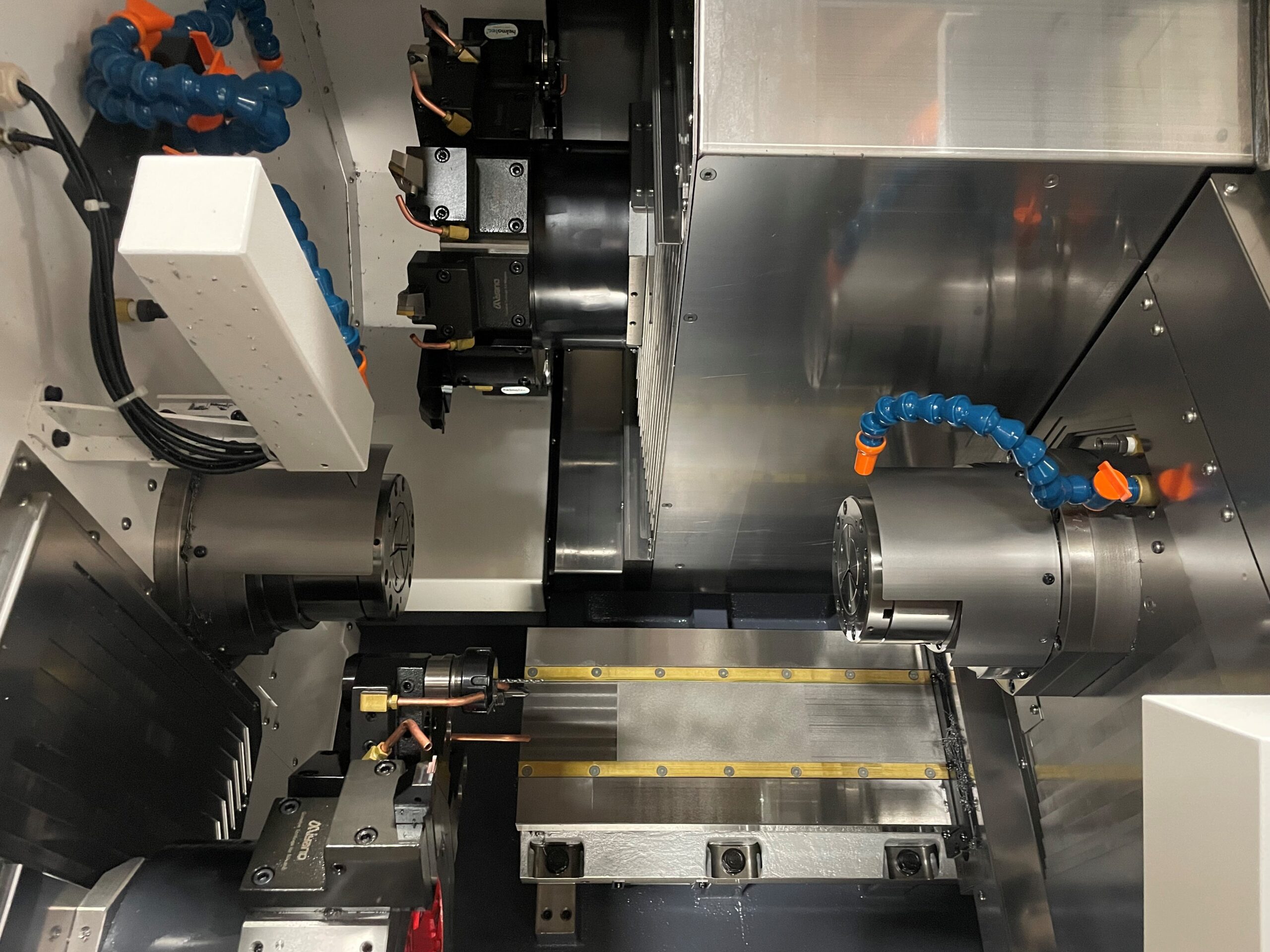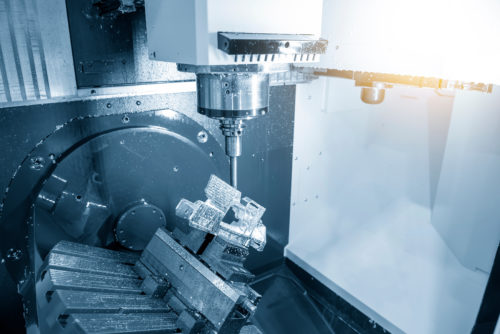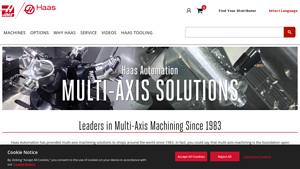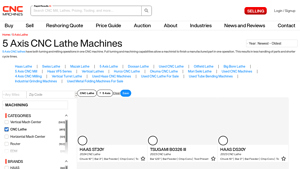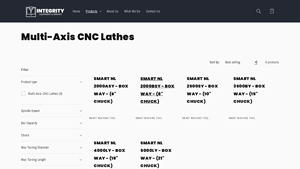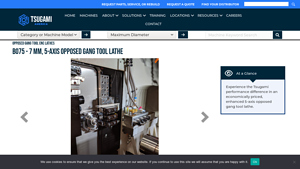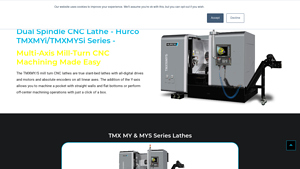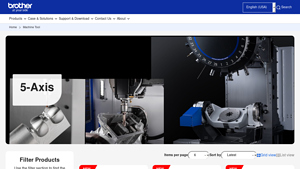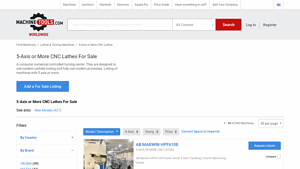Multi Axis Cnc Lathe Guide: Type, Cost, Top List…
Introduction: Navigating the Global Market for multi axis cnc lathe
In today’s competitive manufacturing landscape, sourcing a multi-axis CNC lathe can be a daunting challenge for international B2B buyers. The complexity of these machines, which integrate both turning and milling operations, necessitates a thorough understanding of their capabilities, applications, and the unique needs of various industries. This guide aims to demystify the global market for multi-axis CNC lathes, equipping buyers from Africa, South America, the Middle East, and Europe—including emerging markets like Vietnam and Nigeria—with the insights needed to make informed purchasing decisions.
Throughout this comprehensive guide, we will explore various types of multi-axis CNC lathes, including their specific applications across different sectors, from automotive to aerospace. We will also delve into the critical aspects of supplier vetting, highlighting key criteria to ensure you partner with reputable manufacturers who can deliver quality and reliability. Additionally, we will discuss the cost implications of acquiring these advanced machines, helping you to budget effectively while maximizing your investment.
By providing actionable insights and expert advice, this guide empowers B2B buyers to navigate the complexities of the multi-axis CNC lathe market confidently. Whether you’re looking to enhance production efficiency or meet the growing demands of your clients, understanding the intricacies of this technology will position your business for success in an increasingly globalized economy.
Understanding multi axis cnc lathe Types and Variations
| Type Name | Key Distinguishing Features | Primary B2B Applications | Brief Pros & Cons for Buyers |
|---|---|---|---|
| 5-Axis CNC Lathe | Combines milling and turning capabilities in one setup. | Aerospace, automotive, medical parts | Pros: High precision, reduced cycle time. Cons: Higher initial investment. |
| Y-Axis CNC Lathe | Features a secondary axis for complex geometries. | Oil & gas, heavy machinery | Pros: Versatility in part shapes. Cons: More complex programming required. |
| Swiss CNC Lathe | Designed for high-speed production of small, precise parts. | Electronics, watchmaking | Pros: Excellent for small parts, high efficiency. Cons: Limited to small workpieces. |
| Dual-Spindle CNC Lathe | Equipped with two spindles for increased productivity. | Mass production, automotive | Pros: Improved throughput, simultaneous operations. Cons: More maintenance required. |
| Vertical CNC Lathe | Vertical orientation for space-saving and easy loading. | Aerospace, automotive | Pros: Efficient chip removal, good for heavy parts. Cons: Limited to certain designs. |
What are the Characteristics of 5-Axis CNC Lathes?
5-axis CNC lathes integrate both turning and milling functions, enabling manufacturers to complete complex parts in a single operation. This capability significantly reduces handling time and minimizes the risk of errors associated with multiple setups. Ideal for sectors like aerospace and automotive, these machines require a higher upfront investment but offer exceptional precision and efficiency, making them a valuable asset for companies focused on high-quality output.
How Do Y-Axis CNC Lathes Enhance Machining Versatility?
Y-axis CNC lathes incorporate a secondary axis that allows for intricate machining tasks, enabling the production of complex geometries that traditional lathes cannot achieve. This type is particularly beneficial for industries such as oil and gas and heavy machinery, where part designs often demand versatility. While they provide significant advantages in part complexity, they also necessitate more sophisticated programming and operator training, which may pose challenges for some businesses.
What Makes Swiss CNC Lathes Ideal for Small Parts Production?
Swiss CNC lathes are specifically engineered for the rapid production of small, highly precise components. Their design allows for high-speed machining, making them a preferred choice in industries like electronics and watchmaking. While they excel in efficiency and part accuracy, their capabilities are somewhat limited to smaller workpieces, which buyers must consider when evaluating their production needs and potential market applications.
Why Choose Dual-Spindle CNC Lathes for Mass Production?
Dual-spindle CNC lathes enhance productivity by allowing simultaneous operations, which is crucial for mass production environments. This design is particularly advantageous in the automotive sector, where high throughput is essential. However, the complexity of maintaining dual systems can increase operational costs and require more frequent maintenance, making it important for buyers to assess their production capacity and maintenance capabilities before investing.
What Advantages Do Vertical CNC Lathes Offer for Heavy Parts?
Vertical CNC lathes are designed to accommodate larger and heavier workpieces, with a vertical orientation that facilitates efficient chip removal. They are commonly used in aerospace and automotive applications where robust parts are required. While they excel in handling heavy materials, their design may limit certain geometric possibilities, which buyers need to consider based on their specific production requirements and part designs.
Key Industrial Applications of multi axis cnc lathe
| Industry/Sector | Specific Application of Multi Axis CNC Lathe | Value/Benefit for the Business | Key Sourcing Considerations for this Application |
|---|---|---|---|
| Aerospace | Manufacturing of complex engine components | High precision and reduced lead times | Certification standards, material compatibility, and tooling options |
| Automotive | Production of intricate transmission parts | Enhanced productivity and part consistency | Supplier reliability, maintenance support, and after-sales service |
| Medical Devices | Fabrication of surgical instruments and implants | Compliance with strict regulatory standards | Quality assurance processes, traceability, and customization capabilities |
| Oil & Gas | Creation of specialized fittings and components | Ability to handle tough materials and complex geometries | Material specifications, environmental considerations, and cost-effectiveness |
| Electronics | Production of housings and connectors for devices | Reduced cycle times and improved design flexibility | Technology compatibility, precision requirements, and integration with existing systems |
How is Multi Axis CNC Lathe Utilized in the Aerospace Industry?
In the aerospace sector, multi-axis CNC lathes are pivotal for crafting complex engine components such as turbine blades and housing casings. These machines enable manufacturers to achieve high precision while reducing lead times, which is critical in a field where safety and performance are paramount. Buyers in this industry must consider certification standards and material compatibility, as aerospace components often require specific alloys and treatments to withstand extreme conditions.
What Role Does Multi Axis CNC Lathe Play in Automotive Manufacturing?
The automotive industry leverages multi-axis CNC lathes for the production of intricate transmission parts and engine components. These machines enhance productivity by allowing for simultaneous turning and milling operations, resulting in consistent parts with minimal handling. Automotive manufacturers should prioritize supplier reliability and maintenance support when sourcing these machines, as downtime can significantly impact production schedules.
How is Multi Axis CNC Lathe Essential for Medical Device Manufacturing?
In the medical device sector, multi-axis CNC lathes are used to fabricate surgical instruments and implants with exacting precision. The ability to produce complex geometries while adhering to stringent regulatory standards is vital for ensuring patient safety. Buyers in this field must focus on quality assurance processes and traceability, as the components must meet specific health regulations and are often subject to rigorous testing protocols.
In What Ways Does Multi Axis CNC Lathe Benefit the Oil & Gas Industry?
The oil and gas industry employs multi-axis CNC lathes to create specialized fittings and components that can handle harsh environments and complex geometries. These lathes are capable of machining tough materials like titanium and high-strength alloys, which are essential for durability in this sector. When sourcing, companies should consider material specifications and environmental considerations, as equipment must often withstand extreme conditions and corrosive environments.
How is Multi Axis CNC Lathe Used in Electronics Manufacturing?
In electronics, multi-axis CNC lathes are instrumental in producing housings and connectors for various devices. These machines allow for rapid production cycles and improved design flexibility, which are crucial for keeping pace with the fast-evolving technology landscape. Buyers should assess technology compatibility and precision requirements when sourcing, as the components must fit seamlessly within existing systems while meeting high-quality standards.
3 Common User Pain Points for ‘multi axis cnc lathe’ & Their Solutions
Scenario 1: Complexity in Programming Multi-Axis CNC Lathes
The Problem: Many B2B buyers encounter significant difficulties when programming multi-axis CNC lathes. The complexity of integrating various axes can lead to programming errors, extended setup times, and ultimately, delays in production schedules. For companies in regions such as Africa and South America, where skilled labor may be limited, this challenge can be particularly acute. Furthermore, the lack of standardized training or resources on multi-axis programming adds to the frustration, leaving operators feeling overwhelmed and unprepared.
The Solution: To mitigate these programming challenges, companies should invest in comprehensive training programs for their operators. Collaborating with manufacturers that offer robust training resources or on-site training can bridge the skills gap. Additionally, leveraging simulation software can allow operators to visualize and practice programming in a risk-free environment before executing on the machine. This proactive approach not only enhances operator confidence but also reduces the potential for costly errors during production.
Scenario 2: High Maintenance and Downtime Costs
The Problem: Multi-axis CNC lathes, while highly efficient, can also be prone to wear and tear due to their intricate components and high operational speeds. B2B buyers often face unexpected maintenance costs and machine downtimes, which can severely impact production timelines and profit margins. In fast-paced industries, any unplanned outage can result in delayed deliveries and dissatisfied customers, making it crucial for companies to find ways to optimize machine reliability.
The Solution: Establishing a preventive maintenance schedule is vital for minimizing downtime and maintenance costs. Buyers should partner with machine tool suppliers that provide detailed maintenance guidelines and genuine replacement parts. Implementing a predictive maintenance strategy, using IoT sensors to monitor machine performance, can help identify potential issues before they escalate into major failures. Additionally, maintaining an inventory of critical spare parts can reduce the time needed for repairs, ensuring that production remains uninterrupted.
Scenario 3: Sourcing the Right Multi-Axis CNC Lathe for Specific Needs
The Problem: Selecting the appropriate multi-axis CNC lathe that aligns with specific production requirements can be overwhelming for B2B buyers. With numerous models and configurations available, buyers may struggle to identify the best machine for their operations. This challenge can be compounded by geographic factors, such as limited access to advanced machinery in certain regions, leading to suboptimal purchasing decisions that do not meet production demands.
The Solution: To make informed purchasing decisions, buyers should conduct a thorough needs assessment that considers current and future production volumes, part complexity, and material types. Engaging in consultations with CNC machine experts can provide valuable insights into which models are best suited for specific applications. Additionally, participating in trade shows or industry expos can allow buyers to evaluate machines firsthand and compare features. Establishing relationships with local distributors or manufacturers can also facilitate access to support and service, ensuring that the chosen machine will meet long-term production goals effectively.
Strategic Material Selection Guide for multi axis cnc lathe
What Are the Key Materials for Multi-Axis CNC Lathes?
When selecting materials for multi-axis CNC lathes, it’s crucial to consider their properties, advantages, disadvantages, and suitability for specific applications. Below, we analyze four common materials used in the manufacturing of components for multi-axis CNC lathes.
How Does Aluminum Perform in Multi-Axis CNC Machining?
Aluminum is a lightweight metal known for its excellent machinability and corrosion resistance. It typically has a temperature rating up to 400°F (204°C) and is not prone to rust, making it suitable for various environments.
Pros: Aluminum is relatively inexpensive, easy to machine, and offers good thermal conductivity, which aids in heat dissipation during machining processes. Its lightweight nature makes it ideal for applications where weight reduction is crucial.
Cons: Despite its advantages, aluminum can be less durable than other metals, especially under high-stress conditions. It is also more susceptible to deformation and wear over time.
Impact on Application: Aluminum is often used in aerospace and automotive components due to its favorable strength-to-weight ratio. However, it may not be suitable for applications requiring high-temperature resistance.
Considerations for International Buyers: Compliance with standards such as ASTM B221 for aluminum extrusions is essential. Buyers from regions like Africa and South America should consider local availability and import regulations.
What Role Does Stainless Steel Play in Multi-Axis CNC Lathes?
Stainless steel is renowned for its strength, durability, and corrosion resistance, with temperature ratings that can exceed 1500°F (815°C) depending on the grade.
Pros: Its high tensile strength and resistance to rust make stainless steel ideal for harsh environments. It is also suitable for applications requiring hygiene, such as in the food and pharmaceutical industries.
Cons: The cost of stainless steel is relatively high compared to other materials, and it can be more challenging to machine due to its toughness, potentially leading to increased manufacturing complexity.
Impact on Application: Stainless steel is commonly used in medical devices, automotive parts, and industrial applications where durability and corrosion resistance are paramount.
Considerations for International Buyers: Compliance with standards like ASTM A276 is crucial. Buyers in Europe and the Middle East should be aware of specific grades that meet regional requirements.
Why Choose Titanium for Multi-Axis CNC Machining?
Titanium is a high-performance metal known for its exceptional strength-to-weight ratio and corrosion resistance. It can withstand temperatures up to 1200°F (650°C).
Pros: Titanium’s strength makes it ideal for aerospace applications, where weight is a critical factor. It is also biocompatible, making it suitable for medical implants.
Cons: The primary drawback is its high cost and difficulty in machining, which can lead to longer production times and increased tooling wear.
Impact on Application: Titanium is often used in high-performance applications, including aerospace and medical devices, where both strength and lightweight properties are essential.
Considerations for International Buyers: Buyers should ensure compliance with standards like ASTM F136 for titanium alloys. Regions with emerging markets, such as Africa, may face challenges in sourcing titanium due to its cost.
How Does Carbon Steel Compare for Multi-Axis CNC Lathes?
Carbon steel is a versatile material with good mechanical properties and a temperature rating that can exceed 1000°F (538°C).
Pros: It is generally low-cost and offers good machinability, making it a popular choice for many applications. Its strength makes it suitable for structural components.
Cons: Carbon steel is prone to rust and corrosion if not properly treated, which can limit its use in certain environments.
Impact on Application: It is commonly used in manufacturing tools, machinery parts, and structural components, where high strength is required but corrosion resistance is less critical.
Considerations for International Buyers: Compliance with standards like ASTM A36 is important. Buyers in South America and Africa should consider local steel grades and availability.
Summary Table of Material Selection for Multi-Axis CNC Lathes
| Material | Typical Use Case for Multi Axis CNC Lathe | Key Advantage | Key Disadvantage/Limitation | Relative Cost (Low/Med/High) |
|---|---|---|---|---|
| Aluminum | Aerospace components, automotive parts | Lightweight, excellent machinability | Less durable under high stress | Low |
| Stainless Steel | Medical devices, industrial applications | High strength, corrosion resistant | Higher cost, difficult to machine | High |
| Titanium | Aerospace, medical implants | Exceptional strength-to-weight ratio | Very high cost, challenging to machine | High |
| Carbon Steel | Tools, machinery parts | Low cost, good machinability | Prone to rust without treatment | Low |
This strategic material selection guide provides valuable insights for international B2B buyers, ensuring they make informed decisions tailored to their specific operational needs.
In-depth Look: Manufacturing Processes and Quality Assurance for multi axis cnc lathe
What Are the Key Stages in the Manufacturing Process of Multi-Axis CNC Lathes?
Manufacturing multi-axis CNC lathes involves several critical stages, each designed to ensure precision and quality. The main stages include material preparation, forming, assembly, and finishing.
-
Material Preparation
The first step in manufacturing is sourcing high-quality raw materials, typically metals such as aluminum, steel, or titanium. The choice of material affects not only the machine’s durability but also its performance characteristics. Once sourced, materials undergo cutting and shaping processes to prepare them for machining. This might involve initial machining operations like sawing or shearing to create manageable pieces that fit into the CNC lathes. -
Forming and Machining
During the forming stage, advanced CNC machines perform precise operations. Multi-axis CNC lathes can rotate around multiple axes, allowing for complex shapes and designs to be crafted in a single setup. Techniques such as turning, milling, drilling, and grinding are commonly employed. The versatility of multi-axis lathes reduces the need for multiple setups, which enhances efficiency and reduces cycle times. -
Assembly
After machining, the various components are assembled. This stage often involves intricate work, as precision is crucial. Components such as spindles, tool holders, and drive motors must be fitted together with exacting standards. Experienced technicians utilize specialized tools to ensure that all parts align perfectly, which is vital for the machine’s performance and longevity. -
Finishing
The finishing stage encompasses surface treatments, painting, and protective coatings. These processes not only improve aesthetics but also enhance the machine’s resistance to wear and corrosion. Quality checks during this stage are essential to ensure that the finished product meets both functional and visual standards.
How Is Quality Assurance Implemented in the Manufacturing of Multi-Axis CNC Lathes?
Quality assurance (QA) is a critical aspect of the manufacturing process for multi-axis CNC lathes, ensuring that products meet international standards and customer expectations.
-
What International Standards Are Relevant to CNC Lathe Manufacturing?
Manufacturers often adhere to international standards such as ISO 9001, which outlines criteria for a quality management system. Compliance with this standard demonstrates a commitment to quality and continuous improvement. Other industry-specific standards, such as CE marking for compliance with European health, safety, and environmental protection standards or API standards for oil and gas equipment, may also apply depending on the market. -
What Are the Key QC Checkpoints During Production?
Quality control (QC) checkpoints are integral to maintaining high manufacturing standards. These typically include:
– Incoming Quality Control (IQC): Inspecting raw materials upon arrival to ensure they meet specified standards.
– In-Process Quality Control (IPQC): Monitoring the manufacturing process at various stages to detect and correct issues early.
– Final Quality Control (FQC): Conducting comprehensive testing and inspections before the product is shipped to ensure it meets all specifications and standards. -
Which Testing Methods Are Commonly Used in QC?
Various testing methods are employed to verify the quality of multi-axis CNC lathes, including:
– Dimensional Inspection: Using precision measuring tools to ensure that all parts are within specified tolerances.
– Functional Testing: Running the machine to assess its performance and ensure it operates correctly under expected conditions.
– Non-Destructive Testing (NDT): Techniques such as ultrasonic or magnetic particle inspection to detect internal flaws without damaging the components.
How Can B2B Buyers Verify Supplier Quality Control Processes?
For international B2B buyers, particularly those in regions such as Africa, South America, the Middle East, and Europe, verifying the quality control processes of potential suppliers is crucial.
-
What Steps Can Buyers Take to Audit Suppliers?
Conducting audits is one of the most effective ways to assess a supplier’s quality control systems. Buyers should establish clear criteria for audits, focusing on compliance with international standards, manufacturing processes, and quality assurance protocols. Audits can be performed by the buying company or through third-party inspection services, providing an unbiased evaluation of the supplier’s capabilities. -
What Documentation Should Buyers Request?
Buyers should request detailed documentation from suppliers, including:
– Quality Control Manuals: Outlining the procedures and standards in place.
– Inspection Reports: Providing evidence of compliance with specified standards and testing results.
– Certification Documents: Verifying adherence to international standards like ISO 9001 or industry-specific certifications. -
How Do QC Nuances Affect International Transactions?
Understanding the nuances of quality control across different regions is essential for international buyers. For example, certain certifications may carry more weight in specific markets. Buyers should be aware of local regulations and standards that might affect product acceptance. Additionally, cultural differences in business practices can influence how quality assurance is perceived and implemented.
What Are the Challenges and Solutions in Ensuring Quality Assurance for Multi-Axis CNC Lathes?
While the manufacturing and quality assurance processes for multi-axis CNC lathes are robust, challenges do exist.
-
What Common Challenges Do Manufacturers Face?
– Consistency in Quality: Maintaining consistent quality across multiple production runs can be challenging, especially when scaling operations.
– Technological Advancements: Keeping up with rapid advancements in CNC technology requires continuous investment in training and equipment.
– Supply Chain Issues: Sourcing high-quality materials can be affected by global supply chain disruptions, impacting manufacturing timelines and quality. -
What Solutions Can Be Implemented?
– Investing in Training: Continuous training for employees on the latest technologies and quality control practices can improve overall quality.
– Implementing Advanced Technologies: Utilizing automated quality control systems and real-time monitoring can help detect issues early in the manufacturing process.
– Building Strong Supplier Relationships: Establishing strong partnerships with reliable suppliers ensures a consistent supply of high-quality materials, which is critical for maintaining product quality.
By understanding the manufacturing processes and quality assurance protocols associated with multi-axis CNC lathes, B2B buyers can make informed decisions, ensuring they procure machinery that meets their operational needs and quality standards.
Practical Sourcing Guide: A Step-by-Step Checklist for ‘multi axis cnc lathe’
Introduction
This practical sourcing guide serves as a comprehensive checklist for B2B buyers looking to procure multi-axis CNC lathes. With the increasing complexity of manufacturing processes and the demand for precision, choosing the right equipment is crucial for optimizing production efficiency and ensuring high-quality output. This guide outlines essential steps to help you make informed decisions when sourcing multi-axis CNC lathes.
Step 1: Define Your Technical Specifications
Establishing clear technical specifications is the first step in your sourcing process. Consider the materials you will be machining, the size of the components, and the required tolerances. Detailed specifications ensure that you target machines capable of meeting your production needs without overspending on unnecessary features.
- Key Considerations:
- Maximum and minimum workpiece dimensions.
- Required spindle speed and torque.
- Tooling and workholding compatibility.
Step 2: Research Supplier Options
Conduct thorough research to identify potential suppliers who specialize in multi-axis CNC lathes. Look for manufacturers with a strong reputation in the industry, particularly those who have experience serving markets similar to yours. A well-established supplier is more likely to offer reliable machines and support.
- Where to Look:
- Online directories and B2B marketplaces.
- Industry trade shows and exhibitions.
- Recommendations from industry peers.
Step 3: Evaluate Potential Suppliers
Before making a commitment, it’s crucial to vet suppliers thoroughly. Request company profiles, case studies, and references from buyers in a similar industry or region. This information helps you understand the supplier’s capabilities and reliability.
- What to Assess:
- Quality control processes and certifications (ISO, CE).
- Customer reviews and testimonials.
- After-sales support and service offerings.
Step 4: Request Detailed Quotations
Once you have shortlisted suppliers, request detailed quotations that include pricing, delivery timelines, and terms of service. This step is essential for comparing not just costs but also the value of the offerings provided by each supplier.
- Important Elements to Include:
- Breakdown of costs (machine price, shipping, installation).
- Warranty and service agreements.
- Availability of spare parts and accessories.
Step 5: Assess After-Sales Support and Training
After-sales support is critical for the longevity and performance of your CNC lathe. Ensure that the supplier offers comprehensive training for your staff and ongoing technical support. This can significantly reduce downtime and enhance your team’s operational efficiency.
- Support Features to Look For:
- On-site training sessions for machine operation and maintenance.
- Access to technical documentation and resources.
- Availability of remote support and troubleshooting.
Step 6: Negotiate Terms and Finalize the Purchase
Once you have selected a supplier, negotiate terms that align with your budget and operational needs. Ensure that the contract includes all agreed-upon specifications, pricing, and support services.
- Key Points to Confirm:
- Payment terms and financing options.
- Delivery schedules and installation responsibilities.
- Conditions for warranty claims and service agreements.
Step 7: Prepare for Installation and Integration
Finally, prepare for the installation and integration of the multi-axis CNC lathe into your production environment. This includes ensuring that your facility is equipped to handle the new machine and that your team is ready for operation.
- Preparation Steps:
- Assess facility layout and electrical requirements.
- Schedule time for installation and employee training.
- Plan for any necessary adjustments to existing workflows.
By following these steps, B2B buyers can navigate the complexities of sourcing multi-axis CNC lathes and ensure a successful procurement process that meets their manufacturing needs.
Comprehensive Cost and Pricing Analysis for multi axis cnc lathe Sourcing
Analyzing the cost structure and pricing dynamics of multi-axis CNC lathe sourcing is critical for international B2B buyers. Understanding the various components of cost and the factors influencing pricing can lead to more informed purchasing decisions and better negotiation outcomes.
What Are the Key Cost Components for Multi-Axis CNC Lathes?
-
Materials: The quality and type of materials used in manufacturing multi-axis CNC lathes significantly impact overall costs. High-grade steel and advanced alloys, often utilized for precision and durability, can increase costs. Additionally, the sourcing of raw materials from different regions may affect price due to availability and transportation costs.
-
Labor: Labor costs vary widely based on geographic location and skill level. Regions with lower labor costs may offer competitive pricing, but it is essential to evaluate the skill levels of workers, as this can influence the quality of the final product.
-
Manufacturing Overhead: This includes expenses related to factory operations such as rent, utilities, and equipment maintenance. Efficient manufacturing processes can help reduce these costs, but the scale of production often dictates overhead expenses.
-
Tooling: Tooling costs can be significant, especially for specialized or custom tools needed for specific lathe operations. Buyers should consider whether the supplier has the necessary tooling capabilities to meet their specific needs.
-
Quality Control (QC): Implementing stringent QC processes ensures the reliability and precision of CNC lathes. This can add to costs but is crucial for minimizing defects and maintaining high operational standards.
-
Logistics: Transportation and shipping costs can vary based on distance and shipping methods. International buyers should be aware of the potential for increased costs associated with customs clearance and duties.
-
Margin: Suppliers typically add a profit margin to their base costs. Understanding the typical margin in your target market can help in negotiating more favorable terms.
How Do Price Influencers Affect Multi-Axis CNC Lathe Costs?
-
Volume/MOQ (Minimum Order Quantity): Larger orders often lead to lower per-unit costs due to economies of scale. Buyers should assess their production needs to determine the optimal order size.
-
Specifications and Customization: Custom features and specifications can significantly influence pricing. Buyers should clearly define their requirements to avoid unexpected costs.
-
Quality and Certifications: Machines that meet international standards or have specific certifications may come at a premium. However, investing in certified equipment often results in lower maintenance and operational costs over time.
-
Supplier Factors: The reputation and reliability of the supplier can impact pricing. Established suppliers may charge more but often provide better service and support, which can justify the higher costs.
-
Incoterms: Understanding the terms of trade (Incoterms) is essential for international buyers as it defines the responsibilities of buyers and sellers in shipping and logistics. This can significantly affect overall costs.
What Are Some Buyer Tips for Sourcing Multi-Axis CNC Lathes?
-
Negotiation: Approach negotiations with a clear understanding of cost structures and market pricing. Leverage volume purchasing to negotiate better rates.
-
Cost-Efficiency: Evaluate the Total Cost of Ownership (TCO), which includes not only the purchase price but also maintenance, operation, and potential downtime costs. This holistic view can lead to more strategic purchasing decisions.
-
Pricing Nuances for International Buyers: Be mindful of currency fluctuations and economic conditions in the supplier’s country, as these can affect pricing. Additionally, consider the implications of import duties and taxes in your country.
-
Research and Comparison: Conduct thorough market research and compare quotes from multiple suppliers. This will provide insights into competitive pricing and help identify the best value proposition.
Conclusion
Understanding the cost components and pricing influencers of multi-axis CNC lathes is vital for international B2B buyers looking to optimize their sourcing strategies. By considering factors such as materials, labor, and logistics, along with negotiation tactics and a comprehensive view of costs, buyers can make informed decisions that align with their operational goals. Always remember that prices can vary significantly based on location and market conditions, so it is crucial to conduct due diligence and engage with multiple suppliers.
Alternatives Analysis: Comparing multi axis cnc lathe With Other Solutions
Exploring Alternative Solutions to Multi-Axis CNC Lathes
In the ever-evolving landscape of manufacturing, businesses often seek alternatives to optimize their machining processes. Multi-axis CNC lathes are known for their versatility and efficiency, but other technologies also offer unique advantages. This section will compare multi-axis CNC lathes against two viable alternatives: traditional CNC lathes and Swiss-style CNC lathes. Each option has its strengths and weaknesses, making them suitable for different applications in various industries.
| Comparison Aspect | Multi Axis CNC Lathe | Traditional CNC Lathe | Swiss-Style CNC Lathe |
|---|---|---|---|
| Performance | High precision and flexibility for complex parts | Good for simpler, linear parts | Excellent for small, intricate parts; high-speed machining |
| Cost | Higher initial investment, potential for long-term savings | Lower initial cost, but may require more processes | Moderate cost; can be economical for high-volume production |
| Ease of Implementation | Requires skilled operators and training | Easier to implement and operate | Requires specialized training; setup can be complex |
| Maintenance | Generally low; advanced diagnostics available | Moderate; depends on machine type | High; requires regular calibration and maintenance |
| Best Use Case | Aerospace, automotive, and medical industries | General machining; prototyping | High-precision components in medical and watchmaking industries |
What are the Advantages and Disadvantages of Traditional CNC Lathes?
Traditional CNC lathes are often favored for their simplicity and lower cost. They are well-suited for straightforward turning operations, making them ideal for general machining tasks. The learning curve is less steep compared to multi-axis systems, allowing for quicker implementation. However, they lack the flexibility of multi-axis machines and may require additional processes for complex parts, leading to longer production times and increased handling costs.
How Do Swiss-Style CNC Lathes Compare?
Swiss-style CNC lathes are engineered for high precision and efficiency, especially in the production of small, intricate components. Their design allows for a high-speed machining process, which is advantageous for producing parts with tight tolerances. However, they often come with a higher maintenance requirement and necessitate specialized training for operators. While the initial investment can be moderate, the efficiency gained in high-volume production can lead to significant cost savings over time.
Making the Right Choice: How Do You Determine the Best Solution for Your Business?
When selecting the right machining solution, B2B buyers should consider several factors, including the complexity of the parts being produced, the volume of production, and budget constraints. Multi-axis CNC lathes are ideal for complex, high-precision applications but come with a higher upfront cost. Traditional CNC lathes offer a more economical option for simpler tasks, while Swiss-style lathes excel in high-volume, intricate work but may require a larger investment in training and maintenance.
In conclusion, understanding the specific needs of your operations is crucial. By evaluating the performance, cost, ease of implementation, maintenance requirements, and best use cases of each option, buyers can make informed decisions that align with their production goals and business strategies.
Essential Technical Properties and Trade Terminology for multi axis cnc lathe
What Are the Essential Technical Properties of a Multi-Axis CNC Lathe?
When considering the purchase of a multi-axis CNC lathe, understanding its technical specifications is crucial for making informed decisions that align with production needs and quality standards. Here are several key properties to consider:
-
Axis Configuration
Multi-axis CNC lathes typically range from 3-axis to 5-axis configurations. The more axes a machine has, the more complex geometries it can produce in a single setup. This capability reduces the need for multiple setups, streamlining production processes and minimizing handling time. For businesses in competitive markets, this can lead to significant cost savings and increased throughput. -
Spindle Speed
Measured in revolutions per minute (RPM), spindle speed is a critical parameter affecting machining efficiency and finish quality. Higher spindle speeds enable faster material removal rates, which is essential for high-volume production. Buyers must evaluate the spindle speed in relation to the materials they intend to machine, ensuring compatibility for optimal performance. -
Tooling Capacity
This specification defines how many tools can be loaded and automatically changed during operations. A higher tooling capacity allows for greater versatility and reduces downtime associated with tool changes. For businesses that handle various projects or materials, investing in a machine with a robust tooling system can enhance productivity and adaptability. -
Workpiece Size and Weight Capacity
The machine’s ability to accommodate different sizes and weights of workpieces is crucial. Buyers should consider the maximum dimensions and weight that the lathe can handle to ensure it meets production requirements. This property directly impacts the types of components that can be manufactured, influencing overall business capabilities. -
Tolerance Levels
Tolerance refers to the permissible limit of variation in a physical dimension. Multi-axis CNC lathes are capable of achieving tight tolerances, often within ±0.001 inches. Understanding the tolerance levels required for specific applications is essential, as it directly affects part quality, performance, and compliance with industry standards. -
Material Compatibility
Different multi-axis CNC lathes are designed to work with specific material grades, including metals, plastics, and composites. Knowing the material compatibility allows buyers to select the right machine that can handle their specific production needs, ensuring optimal performance and longevity of the equipment.
What Are Common Trade Terms Related to Multi-Axis CNC Lathes?
In addition to understanding technical properties, familiarity with industry jargon is vital for effective communication and negotiation. Here are several key terms to know:
-
OEM (Original Equipment Manufacturer)
An OEM is a company that produces parts or equipment that may be marketed by another manufacturer. In the context of CNC lathes, understanding OEM relationships can help buyers assess product quality and warranty support. -
MOQ (Minimum Order Quantity)
MOQ refers to the smallest quantity of a product that a supplier is willing to sell. For B2B buyers, knowing the MOQ is crucial for budgeting and inventory management, especially when negotiating bulk purchases. -
RFQ (Request for Quotation)
An RFQ is a document sent to suppliers asking for pricing and other terms for a specific quantity of goods or services. Crafting a detailed RFQ can help buyers secure competitive pricing and favorable terms, ensuring they receive the best value for their investment. -
Incoterms (International Commercial Terms)
Incoterms are a series of predefined international trade terms that clarify the responsibilities of buyers and sellers in shipping and delivery. Understanding these terms is essential for managing logistics and ensuring compliance with international shipping regulations. -
Lead Time
Lead time is the period between the initiation of an order and its completion. For B2B buyers, understanding lead times is crucial for planning production schedules and managing customer expectations. -
TCO (Total Cost of Ownership)
TCO encompasses all costs associated with purchasing, operating, and maintaining a CNC lathe over its lifespan. This metric helps buyers evaluate the long-term financial implications of their investment, beyond just the initial purchase price.
By familiarizing yourself with these technical properties and trade terms, you can make more informed purchasing decisions regarding multi-axis CNC lathes, ultimately enhancing operational efficiency and competitive advantage in your market.
Navigating Market Dynamics and Sourcing Trends in the multi axis cnc lathe Sector
What Are the Current Market Dynamics and Sourcing Trends in the Multi-Axis CNC Lathe Sector?
The global multi-axis CNC lathe market is witnessing robust growth driven by the increasing demand for precision engineering across various industries, including aerospace, automotive, and medical manufacturing. The need for enhanced production capabilities, such as reduced cycle times and improved accuracy, is propelling the adoption of multi-axis CNC machines. International B2B buyers, especially in regions like Africa, South America, the Middle East, and Europe, are increasingly seeking advanced machining solutions to remain competitive. The shift towards automation and Industry 4.0 technologies is also a significant trend, as companies aim to optimize their manufacturing processes and reduce labor costs.
Emerging technologies such as IoT integration and machine learning are influencing sourcing decisions, enabling real-time monitoring and predictive maintenance. Buyers are increasingly interested in suppliers that offer smart manufacturing solutions, enhancing operational efficiency and minimizing downtime. Additionally, the availability of refurbished and used multi-axis CNC lathes at competitive prices is gaining traction, particularly among startups and smaller manufacturers looking to enter the market without heavy initial investments.
How Can Sustainability and Ethical Sourcing Impact the Multi-Axis CNC Lathe Sector?
As environmental concerns gain prominence globally, sustainability is becoming a critical consideration for B2B buyers in the multi-axis CNC lathe sector. The environmental impact of manufacturing processes, including energy consumption and waste generation, is prompting companies to seek machines that adhere to ‘green’ certifications and standards. Buyers are increasingly favoring suppliers who demonstrate a commitment to sustainable practices, such as using recyclable materials and energy-efficient technologies.
Moreover, ethical sourcing is gaining importance in the supply chain. Manufacturers are expected to ensure that their suppliers adhere to ethical labor practices and environmental regulations. This trend is particularly relevant in emerging markets, where buyers are more conscious of the social implications of their sourcing decisions. By prioritizing suppliers with transparent supply chains and sustainability certifications, international buyers can align their operations with global sustainability goals while enhancing their brand reputation.
How Has the Multi-Axis CNC Lathe Sector Evolved Over Time?
The evolution of multi-axis CNC lathes can be traced back to the advancements in CNC technology during the late 20th century. Initially, these machines were primarily utilized for simple machining tasks. However, as industries began to demand higher precision and efficiency, manufacturers innovated to develop machines capable of performing complex tasks, combining both turning and milling operations.
The introduction of five-axis machining marked a significant milestone, allowing for greater flexibility and the ability to produce intricate components in a single setup. This evolution has made multi-axis CNC lathes indispensable in modern manufacturing environments. Today, the integration of digital technologies and automation continues to reshape the landscape, offering enhanced capabilities and driving the demand for more sophisticated machining solutions globally.
Frequently Asked Questions (FAQs) for B2B Buyers of multi axis cnc lathe
-
1. How do I select the right multi-axis CNC lathe for my production needs?
When selecting a multi-axis CNC lathe, consider factors such as the complexity of the parts you intend to produce, the materials you will work with, and your production volume. Evaluate the machine’s specifications, including spindle speed, axis configuration, and tooling options. It’s also essential to assess the machine’s compatibility with your existing software and the support offered by the manufacturer. Engaging with suppliers for demonstrations or seeking feedback from current users can provide valuable insights into performance and reliability. -
2. What is the average lead time for purchasing a multi-axis CNC lathe?
The lead time for acquiring a multi-axis CNC lathe can vary significantly based on the manufacturer, model, and customization requirements. Generally, expect a lead time ranging from a few weeks to several months. Custom-built machines or those with specific configurations may take longer. To expedite the process, it’s advisable to communicate clearly with suppliers about your timeline and explore options for expedited production or shipping if necessary. -
3. What are the key features to look for in a multi-axis CNC lathe?
Key features to consider include the number of axes (typically 5-axis for complex parts), the type of spindle (fixed or rotating), and the machine’s rigidity and accuracy. Additionally, look for advanced control systems that support CAD/CAM integration, automatic tool changers, and live tooling capabilities. Assessing the ease of maintenance and the availability of spare parts is also crucial to minimize downtime in your operations. -
4. How can I ensure the quality of a multi-axis CNC lathe before purchasing?
To ensure quality, request detailed specifications and certifications from the manufacturer, including ISO or CE certifications. It’s beneficial to visit the factory for a live demonstration of the machine in operation. Additionally, inquire about the manufacturer’s warranty and service agreements, as well as customer testimonials or case studies from similar industries. Collaborating with a third-party quality assurance service can provide an extra layer of confidence in your investment. -
5. What are common payment terms when sourcing CNC machinery internationally?
Payment terms can vary widely among suppliers. Typically, expect terms such as a deposit (often 30-50%) upfront, with the balance due prior to shipment or upon delivery. Some suppliers may offer financing options, which can spread costs over time. Ensure clarity on payment methods accepted (e.g., wire transfer, letters of credit) and any associated fees. Negotiating favorable terms can enhance cash flow management for your business. -
6. How do I vet suppliers for multi-axis CNC lathes?
To vet suppliers, start by researching their reputation in the industry through reviews and testimonials. Check for certifications such as ISO 9001, which indicates quality management practices. Request references from previous clients and assess their experience with similar machinery. Additionally, evaluate the supplier’s customer service, support capabilities, and after-sales service. Attending industry trade shows can also provide opportunities to meet suppliers and assess their offerings firsthand. -
7. What is the minimum order quantity (MOQ) for multi-axis CNC lathes?
The MOQ for multi-axis CNC lathes typically depends on the manufacturer and the specific model. Some manufacturers may have a MOQ of one unit, especially for standard models, while others may require larger orders for customized machines. It’s crucial to discuss your needs with suppliers upfront to understand their policies and explore options for smaller orders or pilot programs if you’re just starting. -
8. What logistics considerations should I keep in mind when importing CNC lathes?
When importing CNC lathes, consider shipping methods (air vs. sea), customs regulations, and the associated costs. Ensure that you work with a logistics partner experienced in handling heavy machinery to navigate import duties and tariffs effectively. It’s also important to plan for the delivery, including installation and calibration, which may require specialized equipment or personnel. Finally, ensure that you have adequate insurance coverage during transit to protect your investment.
Important Disclaimer & Terms of Use
⚠️ Important Disclaimer
The information provided in this guide, including content regarding manufacturers, technical specifications, and market analysis, is for informational and educational purposes only. It does not constitute professional procurement advice, financial advice, or legal advice.
While we have made every effort to ensure the accuracy and timeliness of the information, we are not responsible for any errors, omissions, or outdated information. Market conditions, company details, and technical standards are subject to change.
B2B buyers must conduct their own independent and thorough due diligence before making any purchasing decisions. This includes contacting suppliers directly, verifying certifications, requesting samples, and seeking professional consultation. The risk of relying on any information in this guide is borne solely by the reader.
Top 9 Multi Axis Cnc Lathe Manufacturers & Suppliers List
1. Haas Automation – Multi-Axis CNC Machining Solutions
Domain: haascnc.com
Registered: 1996 (29 years)
Introduction: Multi-Axis CNC Machining Solutions from Haas Automation include Y-Axis Lathes and 5-Axis Mills. These machines are designed for advanced machining capabilities, allowing for complex geometries and high precision. The product line emphasizes super-speed features and automation options, catering to various manufacturing needs.
2. Haas – 5 Axis Lathe Machines
Domain: cncmachines.com
Registered: 1997 (28 years)
Introduction: 50% Off Used 5 Axis Lathe Machines – CNCMachines.com. 5 Axis CNC lathes combine turning and milling operations in one machine, allowing for full turning and machining capabilities to finish parts in one operation, reducing handling and cycle times. Available brands include Haas, Mazak, Okuma, Doosan, and more. Options include chip conveyor, tool presetter, tailstock, bar feeder, parts catcher, liv…
3. 5-Axis Mill – DMG Mori, GROB, Hermle, Heller
Domain: reddit.com
Registered: 2005 (20 years)
Introduction: 5-axis mill recommendations: DMG Mori, GROB, Hermle, Heller; Lathe with sub spindle: not specified.
4. Hyundai Wia – HD2200SY CNC Turning Center
Domain: actmachinery.com
Registered: 1999 (26 years)
Introduction: Lathes, CNC (3-Axis or More) – Inventory includes various models such as: 1. Hyundai Wia HD2200SY CNC Multi Axis CNC Turning Center (2020) – Features: Fanuc i Series Control, Chip Conveyor, Auto parts catcher, Y-axis with 4.3″ stroke, Sub Spindle, 12 station turret, Full contouring C-a, Price: $84,500. 2. DOOSAN PUMA 3100LY (2019) – Features: Fanuc i Series, 12″ Chuck, 4″ Bar Capacity, Y Axis, Liv…
5. Integrity Equipment – Multi-Axis CNC Lathes
Domain: integrity-equipment.com
Registered: 2025 (0 years)
Introduction: {‘product_type’: ‘Multi-Axis CNC Lathes’, ‘number_of_products’: 6, ‘spindle_speeds’: [1500, 2000, 4000, 4500, 6000], ‘bar_capacities’: [2, 2.64, 3.19, 4.6, 4.63, 6.56], ‘chucks’: [6, 8, 10, 15, 18, 21], ‘max_turning_diameters’: [15.51, 16.18, 16.9, 21.6], ‘max_turning_lengths’: [28.07, 28.94, 29.53, 57.9, 78.4, 79.4], ‘motor_hp’: [15, 25, 20, 40, 60], ‘spindle_noses’: [‘A2-5’, ‘A2-6’, ‘A2-8’, ‘A2-…
6. Tsugami – B075-III 5-Axis Swiss Type CNC Lathe
Domain: tsugamiamerica.com
Registered: 2020 (5 years)
Introduction: {“model”:”Tsugami B075-III”,”type”:”5-axis Swiss Type CNC Automatic Lathe”,”maximum_bar_stock”:”.275\” (7mm)”,”axes”:”5″,”sliding_headstock_guide_bushing”:”YES”,”max_headstock_stroke_with_guide_bushing”:”2.76\” (70mm)”,”tool_positions”:”21″,”live_tool_positions”:”4″,”control”:”FANUC 0i-TF”,”main_spindle_speed”:”15,000 rpm”,”max_sub_spindle_speed”:”12,000 rpm”,”main_spindle_motor”:”2hp (1.1/1.5kW)”…
7. Hurco – Dual Spindle CNC Lathe
Domain: hurco.com
Registered: 1994 (31 years)
Introduction: Dual Spindle CNC Lathe – Hurco TMXMYi/TMXMYSi Series
– Multi-Axis Mill-Turn CNC Machining
– True slant-bed lathes with all-digital drives and motors
– Absolute encoders on all linear axes
– Y-axis for pocket machining and off-center operations
– Simplified programming and operation via CNC control
– Certified Meehanite® casting for thermal stability
– Oversized guide rails and wide saddle for rigi…
8. Brother – Compact Machining Center
Domain: machinetool.global.brother
Registered: 2017 (8 years)
Introduction: {“products”: [{“name”: “Compact Machining Center”, “series”: [“S Series”, “W Series (Wide Travel)”, “R Series (Pallet Changer)”, “U Series (Universal)”]}, {“name”: “Horizontal Compact Machining Center”, “series”: [“H Series (Horizontal)”]}, {“name”: “Multi Tasking Series”, “series”: [“M Series (Multi-Tasking)”]}, {“name”: “5-Axis Special SPEEDIO Option”, “options”: [“Rotary Table T-200A/T-200Ad”]}…
9. CNC Lathes – 5-Axis Precision Turning Centers
Domain: machinetools.com
Registered: 1995 (30 years)
Introduction: 5-Axis or More CNC Lathes for sale listings include various models from different manufacturers. Key details extracted from the listings are as follows:
– **Types of Machines**: Computer Numerical Controlled (CNC) turning centers designed for modern carbide tooling and processes.
– **Number of Axes**: Ranges from 5 to 10+ axes.
– **Swing Capacity**: Varies from 5.7 inches and under to 31.5 inch…
Strategic Sourcing Conclusion and Outlook for multi axis cnc lathe
As the global manufacturing landscape continues to evolve, the strategic sourcing of multi-axis CNC lathes offers significant advantages for businesses seeking to enhance their operational efficiency and competitiveness. By integrating both turning and milling capabilities into a single machine, companies can reduce cycle times and minimize handling, resulting in greater productivity and cost savings. This technology not only streamlines processes but also allows for more complex parts to be machined with precision.
International B2B buyers, particularly from regions such as Africa, South America, the Middle East, and Europe, should prioritize sourcing high-quality multi-axis CNC lathes from reputable suppliers. Engaging with manufacturers who provide robust support and training can further amplify the benefits of this technology. Additionally, exploring used machinery options can present a cost-effective avenue to access advanced capabilities without compromising on quality.
Looking ahead, the demand for multi-axis CNC lathes is expected to grow as industries increasingly adopt automation and precision engineering. Now is the time to invest in these solutions to secure a competitive edge. Take proactive steps in your sourcing strategy to ensure your business remains at the forefront of innovation in manufacturing.
